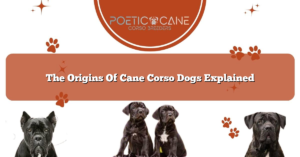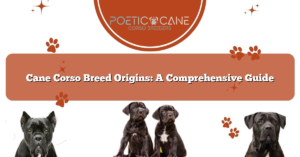Have you ever wondered how the majestic Cane Corso breed came to be?
Prepare to be amazed as we dive into the fascinating development of this remarkable dog.
From its humble origins to its influential role throughout history, the Cane Corso has undergone a series of changes that have shaped its physical characteristics and working abilities.
Join us on this journey as we explore the captivating story behind the evolution of the Cane Corso breed.
Key Takeaways
- The Cane Corso breed originated from ancient Romans using Molossus dogs in warfare and evolved into a working dog for farmers.
- The breed faced a decline in numbers but regained popularity and recognition through dedicated breed enthusiasts.
- The Cane Corso’s physical characteristics were shaped through selective breeding, resulting in a large size, muscular build, and distinct features.
- The Cane Corso has played various roles throughout history, including as guardians, hunting companions, and in military and police work, displaying loyalty, fearlessness, and versatility.
Origin and Early History
You will discover the fascinating origin and early history of the Cane Corso breed.
The Cane Corso, a majestic and powerful breed, has a rich heritage that dates back to ancient times. It’s believed that the breed’s development can be traced back to the Molossus dogs used by the ancient Romans in warfare. These dogs were known for their strength, loyalty, and guarding abilities.
Over the centuries, the Cane Corso’s role evolved from a war dog to a versatile working dog, assisting farmers with tasks such as herding livestock and guarding property.
Unfortunately, during the 20th century, the breed faced a decline in numbers and nearly became extinct. However, thanks to the efforts of dedicated breed enthusiasts, the Cane Corso regained popularity and recognition, becoming a beloved companion and guardian today.
Influences on the Breed
During its development, the Cane Corso breed has been influenced by various factors that have shaped its characteristics and abilities. These influences have played a significant role in making the Cane Corso the remarkable breed it’s today.
Here are three key influences that have contributed to the breed’s development:
- Historical Purpose: The Cane Corso was originally bred as a working dog, primarily used for guarding livestock and property. This purpose influenced the breed’s protective instincts, intelligence, and loyalty.
- Geographic Location: The Cane Corso’s development was influenced by the rugged terrain and harsh climate of its native Italy. These environmental factors contributed to the breed’s robustness, endurance, and adaptability.
- Human Selection: Over the years, dedicated breeders carefully selected Cane Corsos with desirable traits, such as courage, strength, and agility, for breeding. This deliberate human intervention has refined the breed’s characteristics, ensuring its suitability for various tasks and roles.
These influences have shaped the Cane Corso into a versatile and capable breed, known for its loyalty, intelligence, and protective nature.
Evolution of Physical Characteristics
The historical purpose and geographic influences on the Cane Corso breed have led to the evolution of its physical characteristics. Over the years, breeders have selectively bred the Cane Corso for specific traits, resulting in a unique and distinctive appearance.
The breed is known for its large size, muscular build, and powerful stance. Its head is large and square-shaped, with a strong jaw and well-defined cheekbones. The eyes are almond-shaped and set wide apart, giving the Cane Corso an alert and intelligent expression.
Its ears are typically cropped, adding to its imposing presence. The breed’s coat is short and dense, providing protection from the elements. The Cane Corso’s physical characteristics not only make it an impressive and imposing breed, but also contribute to its agility and endurance.
| Physical Characteristics | Description |
|---|---|
| Size | Large |
| Build | Muscular |
| Head | Square-shaped, strong jaw, well-defined cheekbones |
| Eyes | Almond-shaped, set wide apart |
| Ears | Typically cropped |
| Coat | Short and dense |
These physical characteristics combine to create a breed that is both visually striking and functional in various working roles.
Role of Cane Corso in History
Throughout history, Cane Corsos have played a significant role in various working capacities, showcasing their strength, loyalty, and versatility. Their presence has left a lasting impact on society, and their contributions can’t be overlooked. Here are three ways in which Cane Corsos have made their mark:
1) Guardians of property and livestock:
Cane Corsos were bred to protect farms and properties, displaying their unwavering loyalty and fearlessness in the face of danger. Their imposing size and protective instincts made them excellent guardians, ensuring the safety of their owners and their belongings.
2) Hunting companions:
With their exceptional tracking abilities and powerful physique, Cane Corsos were often utilized as hunting partners. Their agility and keen senses made them invaluable in hunting large game, showcasing their versatility and adaptability in different terrains and scenarios.
3) Military and police work:
Cane Corsos have a long history of serving in the military and law enforcement. Their intelligence, courage, and natural protective instincts make them suitable for roles such as search and rescue, detection work, and personal protection. Their presence instills confidence and provides an extra layer of security in challenging situations.
From their origins as working dogs to their modern-day roles, Cane Corsos have proven themselves to be invaluable companions and assets in various fields. Their rich history is a testament to their exceptional qualities and enduring legacy.
Breed Recognition and Standardization
To achieve breed recognition and standardization, you must focus on establishing clear guidelines and criteria for the Cane Corso breed. This involves defining the ideal characteristics, temperament, and physical attributes that exemplify the breed.
The International Cane Corso Federation (ICCF) and the American Kennel Club (AKC) have played crucial roles in setting the breed standards. These organizations have outlined specific requirements for the Cane Corso’s appearance, size, coat, and temperament.
The breed standard serves as a blueprint for breeders and judges, ensuring consistency and uniformity in the breed. It also helps potential owners understand the breed’s characteristics and make informed decisions.
Breed recognition and standardization are important steps in preserving the integrity and heritage of the Cane Corso breed, allowing it to flourish and thrive for generations to come.
Modern Challenges and Preservation Efforts
Preserving the integrity and heritage of the Cane Corso breed involves addressing modern challenges and actively engaging in preservation efforts. To ensure the breed’s continued existence and well-being, here are three key areas that need attention:
- Health concerns: Like many large breeds, Cane Corsos are prone to certain health issues such as hip dysplasia and bloat. Breeders and owners must prioritize health screenings and responsible breeding practices to minimize the occurrence of these conditions and preserve the breed’s vitality.
- Temperament and socialization: The Cane Corso is known for its protective nature and loyalty. However, proper socialization from an early age is crucial to ensure that these traits are well-balanced and the dog can interact safely with people and other animals.
- Responsible ownership: With the rise in popularity of the breed, it’s essential for owners to understand the commitment and responsibility that comes with owning a Cane Corso. Responsible ownership includes providing proper training, exercise, and mental stimulation, as well as being aware of legal responsibilities and breed-specific regulations.
Training and Working Abilities
To ensure the preservation of the Cane Corso breed’s working abilities, responsible owners must focus on their training and development.
The Cane Corso is a highly intelligent and trainable breed, known for its versatile working capabilities. These dogs excel in various roles such as guarding, tracking, and even search and rescue operations.
Training should begin at an early age to establish proper behavior and socialization skills. Consistency, positive reinforcement, and firm but fair handling are essential for successful training.
It’s important to challenge their mental and physical abilities through obedience exercises, agility training, and interactive play. The Cane Corso’s natural instincts and protective nature make them excellent candidates for jobs that require strength, endurance, and a keen sense of loyalty.
Popularity and Demand
As the popularity of the Cane Corso breed continues to grow, it’s important for prospective owners to understand the demand for these remarkable dogs. Here are three reasons why the demand for Cane Corsos is on the rise:
1) Loyalty: Cane Corsos are known for their unwavering loyalty and devotion to their owners. They’ll go to great lengths to protect and please their family, making them highly sought after as loyal companions.
2) Versatility: These dogs excel in various roles, including as family pets, guard dogs, and working dogs. Their versatility makes them appealing to individuals with different needs and lifestyles.
3) Appearance: With their muscular build, expressive eyes, and regal presence, Cane Corsos are undeniably striking. Their majestic appearance attracts attention and admiration, adding to their increasing popularity.
As the demand for Cane Corsos continues to rise, it’s crucial for prospective owners to carefully consider their commitment and responsibility in owning one of these remarkable dogs.
Future Prospects and Adaptability
If you’re considering adding a Cane Corso to your family, it’s important to understand their future prospects and adaptability.
The Cane Corso breed has a promising future due to its increasing popularity and demand. With their strong and muscular build, they’re well-suited for various tasks such as guarding, herding, and even search and rescue.
Their intelligence and trainability make them adaptable to different environments and lifestyles. Whether you live in an apartment or have a spacious yard, the Cane Corso can adjust to your living situation. However, it’s crucial to provide them with regular exercise and mental stimulation to keep them happy and healthy.
Additionally, early socialization and consistent training are essential to ensure they become well-behaved and well-rounded companions.
Frequently Asked Questions
Are Cane Corsos Good With Children and Other Pets?
Cane Corsos are generally good with children and other pets. They are protective and loyal, making them great family pets. However, it’s important to socialize them early and supervise interactions to ensure everyone’s safety.
What Is the Average Lifespan of a Cane Corso?
The average lifespan of a Cane Corso is around 9 to 12 years. They are generally healthy dogs, but like any breed, they may be prone to certain health issues as they age.
How Much Exercise Does a Cane Corso Need on a Daily Basis?
You’ll be surprised to know that a Cane Corso needs a good amount of exercise on a daily basis. They are active dogs who thrive when they have plenty of physical activity to burn off their energy.
Are Cane Corsos Prone to Any Specific Health Issues?
Cane Corsos can be prone to specific health issues. Regular vet check-ups and a healthy diet are important for maintaining their well-being. It’s essential to be aware of these potential health concerns and take preventive measures.
Can Cane Corsos Be Left Alone for Long Periods of Time?
You shouldn’t leave a Cane Corso alone for long periods of time. They thrive on human companionship and can become anxious or destructive when left alone. Make sure they have plenty of mental and physical stimulation.

Sydney Kimberly is a passionate Cane Corso lover and dedicated breeder. With years of experience, she’s committed to raising these majestic dogs, ensuring they thrive in loving homes. Sydney’s expertise shines in her dedication to preserving the breed’s excellence, temperament, and health. Discover more about her Cane Corso journey and insights.




